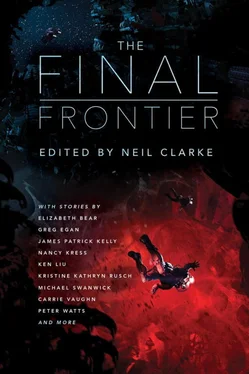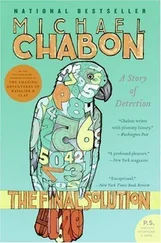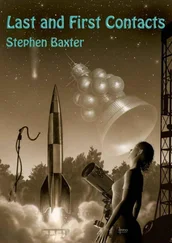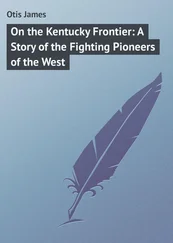It doesn’t surprise me that Karl, who claimed not to be afraid, is nervous. He’s the one who had doubts about this trip once he’d been inside the wreck. He’s the one I thought wouldn’t make it through all of his scheduled dives.
The cockpit looms in front of us, the doors stuck open. It does look like a battlefield from this vantage: the broken furniture, the destruction all cobbled together on one side of the room, like a barricade.
The odd part about it is, though, that the barricade runs from floor to ceiling, and unlike most things in zero-G, seem stuck in place.
Neither Karl nor I give the barricade much time. We’ve vowed to explore the rest of the cockpit first, looking for the elusive dead-man switch. We have to be careful; the sharp edges are everywhere.
Before we left, we used the visuals from Jypé’s suit, and his half-finished map, to assign each other areas of the cockpit to explore. I’m going deep, mostly because this is my idea, and deep—we both feel—is the most dangerous place. It’s closest to the probe, closest to that corner of the cockpit where Junior still hangs, horizontal, his boots kicking out into the open.
I go in the center, heading toward the back, not using hand-holds. I’ve pushed off the wall, so I have some momentum, a technique that isn’t really my strong suit. But I volunteered for this, knowing the edges in the front would slow me down, knowing that the walls would raise my fears to an almost incalculable height.
Instead, I float over the middle of the room, see the uprooted metal of chairs and the ripped shreds of consoles. There are actual wires protruding from the middle of that mess, wires and stripped bolts—something I haven’t seen in space before, only in old colonies—and my stomach churns as I move forward.
The back wall is dark, with its distended screen. The cockpit feels like a cave instead of the hub of the Dignity Vessel. I wonder how so many people could have trusted their lives to this place.
Just before I reach the wall, I spin so that I hit it with the soles of my boots. The soles have the toughest material on my suit. The wall is mostly smooth, but there are a few edges here, too—more stripped bolts, a few twisted metal pieces that I have no idea what they once were part of.
This entire place feels useless and dead.
It takes all of my strength not to look at the barricade, not to search for the bottoms of Junior’s boots, not to go there first. But I force myself to shine a spot on the wall before me, then on the floor, and the ceiling, looking for something—anything—that might control part of this vessel.
But whatever had, whatever machinery there’d been, whatever computerized equipment, is either gone or part of that barricade. My work in the back is over quickly, although I take an extra few minutes to record it all, just in case the camera sees something I don’t.
It takes Karl a bit longer. He has to pick his way through a tiny debris field. He’s closer to a possible site: there’s still a console or two stuck to his near wall. He examines them, runs his suit-cam over them as well, but shakes his head.
Even before he tells me he’s found nothing, I know.
I know.
I join him at a two-pronged hand-hold, where his wall and mine meet. The handhold was actually designed for this space, the first such design I’ve seen on the entire Dignity Vessel.
Maybe the engineers felt that only the cockpit crew had to survive uninjured should the artificial gravity go off. More likely, the lack of grab bars was simply an oversight in the other areas, or a cost-saving measure.
“You see a way into that barricade?” Karl asks.
“We’re not going in,” I say. “We’re going to satisfy my curiosity first.”
He knows about the dream; I told him when we were suiting up. I have no idea if Turtle heard—if she did, then she knows too. I don’t know how she feels about the superstitious part of this mission, but I know that Karl understands.
“I think we should work off a tether,” he says. “We can hook up to this handhold. That way, if one of us gets stuck—”
I shake my head. There are clearly other bodies in that barricade, and I would wager that some of them have tethers and bits of equipment attached.
If the stealth tech is as powerful as I think it is, then these people had no safeguard against it. A handhold won’t defend us either, even though, I believe, the stealth tech is running at a small percentage of capacity.
“I’m going first,” I say. “You wait. If I pull in, you go back. You and Turtle get out.”
We’ve discussed this drill. They don’t like it. They believe leaving me behind will give them two ghosts instead of one.
Maybe so, but at least they’ll still be alive to experience those ghosts.
I push off the handhold, softer this time than I did from the corridor, and let the drift take me to the barricade. I turn the front suit-cams on high. I also use zoom on all but a few of them. I want to see as much as I can through that barricade.
My suit lights are also on full. I must look like a child’s floaty toy heading in for a landing.
I stop near the spot where Junior went in. His boots are there, floating, like expected. I back as far from him as I can, hoping to catch a reflection in his visor, but I get nothing.
I have to move to the initial spot, that hole in the barricade that Junior initially wanted to go through.
I’m more afraid of that than I am of the rest of the wreck, but I do it. I grasp a spot marked on Jypé’s map, and pull myself toward that hole.
Then I train the zoom inside, but I don’t need it.
I see the side of Junior’s face, illuminated by my lights. The helmet is what tells me that it’s him. I recognize the modern design, the little logos he glued to its side.
His helmet has bumped against the only intact console in the entire place. His face is pointed downward, the helmet on clear. And through it, I see something I don’t expect: the opposite of my fears.
He isn’t alive. He hasn’t been alive in a long, long time.
As I said, no one understands interdimensional travel, but we suspect it manipulates time. And what I see in front of me makes me realize my hypothesis is wrong:
Time sped up for him. Sped to such a rate that he isn’t even recognizable. He’s been mummified for so long that the skin looks petrified, and I bet, if we were to somehow free him and take him back to the Business , that none of our normal medical tools could cut through the surface of his face.
There are no currents and eddies here, nothing to pull me forward. Still, I scurry back to what I consider a safe spot, not wanting to experience the same fate as the youngest member of our team.
“What is it?” Karl asks me.
“He’s gone,” I say. “No sense cutting him loose.”
Even though cutting isn’t the right term. We’d have to free him from that stealth tech, and I’m not getting near it. No matter how rich it could make me, no matter how many questions it answers, I no longer want anything to do with it.
I’m done—with this dive, this wreck—and with my brief encounter with greed.
We do have answers, though, and visuals to present to the government ships when they arrive. There are ten of them—a convoy—unwilling to trust something as precious as stealth tech to a single ship.
Squishy didn’t come back with them. I don’t know why I thought she would. She dropped off Jypé, reported us and the wreck, and vanished into Longbow Station, not even willing to collect a finder’s fee that the government gives whenever it locates unusual technologies.
Squishy’s gone, and I doubt she’ll ever come back.
Turtle’s not speaking to me now, except to say that she’s relieved we’re not being charged with anything. Our vids showed the government we cared enough to go back for our team member, and also that we had no idea about the stealth tech until we saw it function.
Читать дальше












